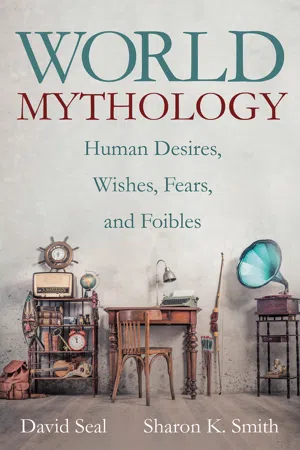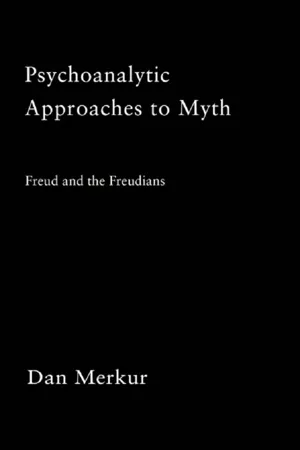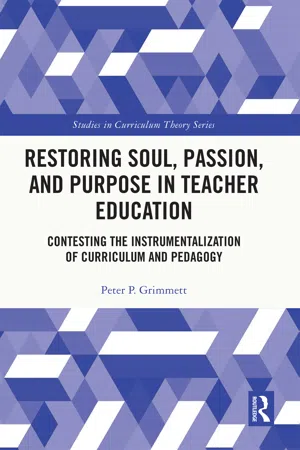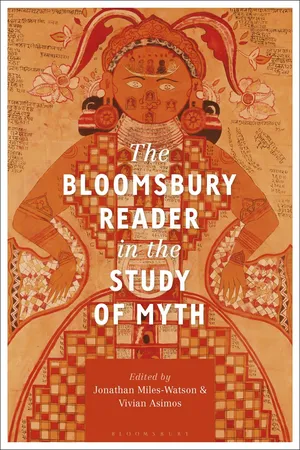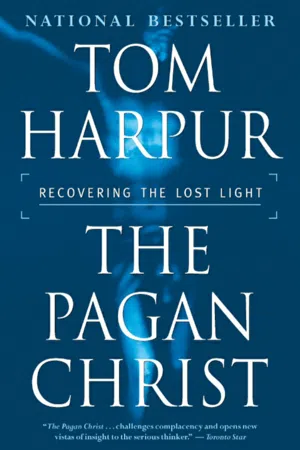Myth
A myth is a traditional story that typically explains the origins of a culture, natural phenomena, or religious beliefs. It often features gods, heroes, and supernatural beings, and is passed down orally or through written literature. Myths serve to convey cultural values, beliefs, and customs, and are an important part of literary traditions worldwide.
7 Key excerpts on "Myth"
- eBook - ePub
World Mythology
Human Desires, Wishes, Fears, and Foibles
- David Seal, Sharon K. Smith(Authors)
- 2021(Publication Date)
- Wipf and Stock(Publisher)
...The world’s Mythologies reflect human curiosities, wishes, desires, fears, foibles, and concerns. We want to encourage you to discover these commonalities that bind together a culturally diverse humanity. Characteristics of a Myth To read a Myth effectively, one needs to know the nature of the literature. A survey of the many books on Mythology will reveal that there is no one definition of Myth. William Doty devotes two entire chapters to defining Myth. Doty lists the following attributes: 1 1. A Mythological corpus consists of a complex network of Myths that are culturally important to the people that composed and preserved them. Myths are a communal possession; they have obtained currency because of their acceptance by a community. 2 Over an extended period, a group has endorsed certain stories which address some of the larger questions about human life. 2. The Myths portray a world where the characters, including deities and other supernatural beings, 3 are treated as having the same visibility as anything else you might consider as existing. Even the physical world in Myths—rivers, streams, woods, mountains, and the very earth itself—is alive with the divine presence. In short, Myths deal with a numinous order of reality behind the appearances of the phenomenal world. Furthermore, the transcendent figures of the Mythical world are represented as taking part in activities on a cosmic scale, which exert a permanent causal influence on earthly happenings. 4 When Myth is employed, it presupposes that humanity has learned to make some distinction between the natural and transcendent realm...
- eBook - ePub
- Daniel Merkur(Author)
- 2005(Publication Date)
- Routledge(Publisher)
...Before attempting to explain why the correlation is intrinsic to the nature of Myth, let us examine existing criteria for the definition of Myth in perspective of the evidence of metaphoric interpretation. Myths are variously defined in different scholarly disciplines. Folklorists and anthropologists tend to regard Myths as a genre of oral narratives that may be contrasted to legends and folktales (Bascom 1965). Because Myths are intrinsically religious, the most sensitive definitions of the genre have been produced by Scandinavian scholars who approach the genre from an interdisciplinary standpoint in folkloristics and the history of religions. Let us consider two proposals. Lauri Honko (1972, 16–18) advocated an inclusive description of Myths as verbal narratives that generally concern “decisive, creative events in the beginning of time.” Myths function as examples or models, both by embodying a worldview and by serving as practical models of behavior. In the main, their context is to be found in rites that re-actualize the primordial events that they portray. Âke Hultkrantz (1979, 84) considered Honko’s criteria unnecessarily cumbersome, however, and offered an exclusive definition of native North American Myths. Myths are believed true. They are set at the beginning of time, and their protagonists are supernatural beings. Both scholars’ definitions reflect the consensus that Myths mean no more than they say. The definitions may be revised in perspective of the evidence of metaphoric interpretation. By definition, Myths are believed true. The question must be raised, however, as to the sense in which Myths are believed true. Rodney Needham (1972) ably documented the complexity of the comparative phenomena that are described as belief in academic literature. To the extent that ethnographic religions depend on vision quests, shamanism, spirit possession, spirit mediumship, and so forth, they are experienced religions that take belief for granted...
- eBook - ePub
Restoring Soul, Passion, and Purpose in Teacher Education
Contesting the Instrumentalization of Curriculum and Pedagogy
- Peter Grimmett(Author)
- 2021(Publication Date)
- Routledge(Publisher)
...Stories, then, engross us in the study of lived experience, a study that more often then not unfolds pearls of practical wisdom. Stories are luminous chronicle forms that are at once art and pedagogy. Myth as bedazzling, revealing narrative enters by the back door of artistry into the fray of philosophical and pedagogical exploration, tantalizing the reader with an unseen world. C.S. Lewis (1936) believed that Myth and other imaginative forms of tale telling are helpful to “hold back the demon of compulsive exposition,” a tendency to over-explain that which to some extent defies explanation anyway; they help the author who is dealing with mystery to “say best what needs to be said” (Humphrey 2018, p. 11). Joseph Campbell’s 2 early work discovered similarities in Myths from around the globe, revealing their deeper meanings. His aim was for humans to delve deeply into the Myths so as to discover that they are speaking to what is already part of our make-up. Throughout the inhabited world … Myths … have flourished; and they have been the living inspiration of whatever else may have appeared out of the activities of the human body and mind … Myth is the secret opening through which the inexhaustible energies of the cosmos pour into the human cultural manifestation. Religions, philosophies, arts, and the social forms of primitive and historic man, prime discoveries in science and technology, the very dreams that blister sleep, boil up from the magic ring of Myth. The wonder is that characteristic efficacy to touch and inspire deep creative centers dwells in the smallest nursery fairy tale—as the flavor of the ocean is contained in a droplet or the whole mystery of life within the egg of a flea. For the symbols of Mythology are not manufactured; they cannot be ordered, invented, or permanently suppressed. They are spontaneous productions of the psyche and each bears within it, undamaged, the germ power of its source. (Campbell, 1949, pp...
- eBook - ePub
- Jonathan Miles-Watson, Vivian Asimos, Jonathan Miles-Watson, Vivian Asimos(Authors)
- 2019(Publication Date)
- Bloomsbury Academic(Publisher)
...I have tried to show that folklore, these stories handed on in a native community, live[s] in the culture context of tribal life and not merely in narrative. By this I mean that the ideas, emotions, and desires associated with a given story are experienced not only when the story is told, but also when in certain customs, moral rules, or ritual proceedings, the counterpart of the story is enacted. And here a considerable difference is discovered between the several types of story. While in the mere fireside tale the sociological context is narrow, the legend enters much more deeply into the tribal life of the community, and the Myth plays a most important function. Myth, as a statement of primeval reality which still lives in present-day life and as a justification by precedent, supplies a retrospective pattern of moral values, sociological order, and magical belief. It is, therefore, neither a mere narrative, nor a form of science, nor a branch of art or history, nor an explanatory tale. It fulfills a function sui generis closely connected with the nature of tradition, and the continuity of culture, with the relation between age and youth, and with the human attitude towards the past. The function of Myth, briefly, is to strengthen tradition and endow it with a greater value and prestige by tracing it back to a higher, better, more supernatural reality of initial events. Myth is, therefore, an indispensable ingredient of all culture. It is, as we have seen, constantly regenerated; every historical change creates its Mythology, which is, however, but indirectly related to historical fact...
- eBook - ePub
Introducing Religion
Religious Studies for the Twenty-First Century
- Robert S. Ellwood(Author)
- 2019(Publication Date)
- Routledge(Publisher)
...The point of a Myth is not whether it is accurate in every detail, but what it says about the subject and, beyond that, about the kind of world we live in and what our lives should be like. We need such stories because our lives are stories, not abstractions. Myths, the telling of important truths in story form, go back to oral culture before the invention of writing, and they reflect a different way of thinking from what emerged with literacy. They say the way to pass on important information is by telling a story about it. One example is trickster Myths like that of Coyote. Kinds of Myth include cosmogonic or creation accounts, Myths of the origin or evil and death, hero Myths, and eschatological Myths or stories of the coming end of days. Creation Myths tell in story form a great deal about how we are to think of the world by telling how it was made, or how it repeats itself in endless cycles. The hero Myth can be divided into Myths of the warrior hero, such as Hercules, and the savior hero, such as Jesus. In reflecting on the meaning of Myth, we can think about how they tell us how chains of events were set in motion, or exemplified, that affect our lives today. Key Terms cosmogonic Myth, p. 44 eschatology, p. 44 hero/savior Myth, p. 55 Myth, p. 40 Notes 1. Summarized in Walter J. Ong, Orality and Literacy: The Technologizing of the Word (New York: Routledge, 1982), 49–56. See Aleksandr Romanovich Luria, Cognitive Development: Its Cultural and Social Foundations, trans. by Martin Lopez-Morillas and Lynn Solotaroff (Cambridge, MA: Harvard University Press, 1976). 2. Walter J. Ong, Orality and Literacy, 13–15. 3. Claude Levi-Strauss, “The Structural Study of Myth,” Journal of American Folklore, LXXVIII, 270, Oct.-Dec. (1955): 428–444...
- eBook - ePub
Bowstring
On the Dissimilarity of the Similar
- Viktor Shklovsky, Shushan Avagyan(Authors)
- 2011(Publication Date)
- Dalkey Archive Press(Publisher)
...“Myth” AND “THE NOVEL-Myth” About Myth Myth was believed to be the prototypical poetic genre; they asserted that philosophy and science emerged from Myth. Schelling wrote about this in his Philosophy of Art over a hundred and fifty years ago. For a long time they thought that fairy tales were the echoes of Myths, that they deified celestial phenomena. They explained the similarity of fairy tales by their origination from a singular (usually Aryan) source. Myths were restored and connected to one another in various ways. The Russian folklorist Aleksandr Afanasyev studied fairy tales and his definitive work on the subject, Poetic Views of the Slavs on Nature, was published in three volumes between 1866 and 1869. The influence of Afanasyev’s work can be seen in the works of many writers; I remember how Yesenin was enamored by this book and how he wrote a tract on literature, “Maria’s Keys.” This fascination and burgeoning curiosity for Myths has returned, or reemerged today in the form of neo-Mythologism. The recurrence is marked by a great change and enrichment in theory. Carl Jung wrote on psychological archetypes—primordial generic models produced by the collective unconscious of mankind. To be sure, Mythology precedes literature and defines it in many ways. Myths in human memory are like tools in a smithy—they are meant for work, not for storage. Myths are selected for the construction of a new aesthetic structure. Greek Mythology invented the tools and methods of their use in the construction of Greek art. It found the laws of art in Mythology. But there are many Myths in the world and they are more diverse than the tongs and hammers in a smithy. Different poets, while working on the history of one and the same hero, chose various Myths as material and sometimes were reproached for this. The Myth of Medea who takes revenge against her husband by stabbing their children to death was not the most well-known story...
- eBook - ePub
The Pagan Christ
Recovering the Lost Light
- Tom Harpur(Author)
- 2005(Publication Date)
- Thomas Allen Publishers(Publisher)
...The series, which has often been repeated and reposes on the video shelves of many thousands of people the world over, made plain, in the simplest of terms, the essential ability of Myths to change states of consciousness and to impart sublime truths accessible in no other way. It showed, among other things, how each one of us is affected by the Myths not only of the past but of the culture around us today. Nevertheless, it is safe to say that there are, at this moment, few words in our language less comprehended, or for that matter valued, than the word “Myth.” Mention “Myth” or “Mythology” to the average person, and he or she will assume that you are speaking of remote, insubstantial, irrelevant matters. In our culture, the word is synonymous with, at best, fairy tales and, at worst, outright lies and deception. If you pay attention, you’ll be amazed at how often you’ll read or hear someone say, “It’s only a Myth.” Since this book will frequently deal with Myth, it is of paramount importance that this disastrous distortion and misunderstanding be met head on. Inasmuch as the arguments advanced will lead inexorably to the conclusion that the entire Gospel story of Jesus—not to mention about 95 percent of the rest of the Bible—is a Myth or a collection of the same, it is imperative that the true meaning of Myth receive detailed attention. Here are three brief quotes from Kuhn to underline this salient point in my argument: • “What was known of old. . . is that the Myth as employed by ancient illuminati in Biblical scripture is not fiction, but the truest of all history!” • “The Myth is the only true narrative of the reality of human experience. It is the only ultimately true history ever written. . . as it is the actual experience of life in its evolution. Real as history is, it is finally less true than the Myth...
